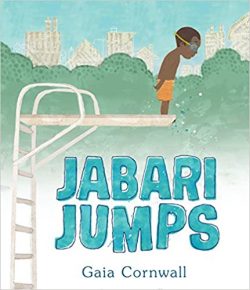Jabari Jumps
Jabari Jumps: Overview and Description

Plot
This story is about a young boy who goes to the swimming pool with his father and wants to jump from the high diving board but is afraid to do so. With self reassurances and encouragement from his dad, Jabari eventually overcomes his fear and not only climbs up the ladder but jumps off the board into the water, feeling the success and joy that results from persevering and conquering one’s fears.
Math Practice (Perseverance)
As Jabari bravely works toward jumping off the high dive, young children can see what it looks like for a character to stick with something, even when they may be scared. Jabari models – and allows us to discuss – perseverance. We can make connections between the ways Jabari is brave with something new and the way mathematicians must be brave with new ideas. Mathematicians – like Jabari – stick with problems, even when they are challenging. We can support young mathematicians to know that the feeling of struggle can be exciting and exhausting!
Math Content
Even though this book is not an overtly mathematical story, there are many opportunities to discuss and learn mathematical content. Children may notice and count how many children are in line at the diving board OR how many rungs on the ladder. They may be curious to know how high is the diving board and wonder about the relationship between the height of the board and the depth of Jabari’s plunge into the deep end of the pool!
Read Alouds: Let’s Read Together
Try one (or all) of the three read alouds provided below.
Open Notice and Wonder Read
Enjoy a first read where you follow children’s interest, pausing where there is energy to ask, What do you notice? and/or What do you wonder? Celebrate hearing children’s ideas!
Math Lens Read
A math lens read can go back to revisit what children noticed and wondered mathematically during the first read! You may or may not read entirely through or perhaps jump to focal parts of the story to think about the theme of perseverance. For example, you might say, “You noticed Jabari felt scared as he watched other children climb the long ladder and jump. You noticed he squeezed his dad’s hand. You wondered how tall the diving board is. Let’s think more about your wonder. How tall do you think the board is? How could we estimate the height?” OR you might pause to think more about the strategies Jabari uses to work through his fear, saying, “You noticed Jabari took a deep breath and said, ‘I love surprises’. What do you do when you feel scared but want to try something new? What is an example of a new idea you have tried – or a risk you have taken – as a mathematician?”
Story Explore Read
A story explore read can go back to revisit what children noticed and wondered about the story during the first read! You may or may not read entirely through or perhaps jump to focal parts of the story to think as readers. For example, you might say, “You noticed Jabari’s actions and feelings don’t always seem to agree with what he is saying. Let’s go back and think about the words and ideas Jabari is saying as he works to climb the ladder and jump into the pool—do they match what he is doing or how he is feeling?!” OR you might pause on pages where Jabari might be feeling powerful emotions and ask, “How is he feeling right now? Have you ever felt this way, and if so, what caused you to feel like this and what helped you feel better?”
